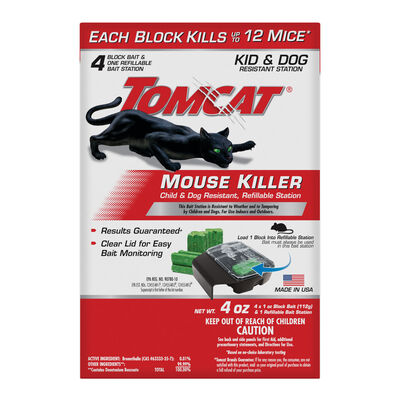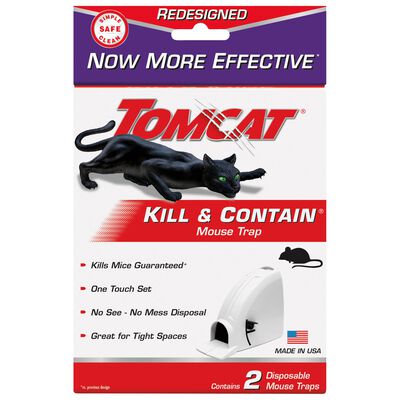
Identifying a Mouse or Rat Problem in Your House
Tips for discovering the nature of—and solution for—your rodent problem.
A thorough home inspection will help you determine the type of rodent you're dealing with, their patterns of activity, what's bringing them inside your home, and most importantly, which rodent-control product to use for eliminating them.
The first step to getting rid of mice or rats is figuring out which rodent you're dealing with - and how big your problem is. Before you take any steps to control a rodent problem, be sure to inspect your home, inside and out. Conducting a thorough inspection will be critical for helping you decide which method of control is right for you.
Inspecting for Rodents
With a flashlight, examine dark areas, such as behind appliances and in cupboards or closets, where rodents like to hide. And be sure to look up, down and all around for signs where rodents travel.
A good inspection will help you determine:
- The type of rodent - is it a house mouse, Norway rat or roof rat?
- The severity of the problem
- Where they eat, travel, and nest
- The cause of your problem - whether it's poor sanitation, available food, or water
- The best type of rodent control product to use and where to place it for success
Signs of Rodents
Tell-tale signs of rats and mice include:
- Droppings
- Urine odors
- Gnawed holes
- Rub and gnaw marks
- Rodent runways
- Rodent nests
- Scampering noises
- Unusual pet behavior

How to Tell if You Have Mice or Rats
You know or suspect there are rodents in the house, but how can you tell if you're dealing with mice or rats? Even though they share common signs, use their unique indicators to find out what kind of rodents are present. This is also important so you know the right bait or trap to use to get rid of them.
Appearance. Rats are larger than mice and will have coarse red, brown, grey, or black fur (depending on the variety) and a long, scaly, fur-less tail. A mature rat can range from 11-19 inches long (including its tail) and weigh ½ to 1 pound.
Mice have large ears and tiny black eyes. They have fine fur that can be black, grey, or brown and a 3-4 inch long, hairless tail. Mature mice grow to about 6-7 inches long (including its tail) and weigh ½ to 1oz.
Droppings. Rodent droppings are a sure sign that rats or mice are present, and will indicate the type of rodent, the size of the infestation, and where they are most active.
- Mouse droppings are small, less than ¼ inch, and pointed on both ends.
- Rat droppings are ½ inch or larger.
- Norway Rat droppings are blunt at both ends, while Roof Rat droppings have pointed ends.
New droppings are shiny and putty-like in texture, while old ones are hard and crumbly. Varying feces sizes indicate that juveniles and adults are present, and lots of droppings may be an indication of a large infestation. The location of the droppings indicates active areas where you should place bait or traps.
Urine Odor. Rodent urine has a strong musky odor. With large infestations, you can easily smell it.
Gnawed Holes. Gnawed mouse holes are small, clear-cut, and about the size of a dime. Gnawed rat holes are large, about the size of a quarter, with rough torn edges.
Rub and Gnaw Marks. Oily rub marks are left in places where rodents travel along walls. If rub marks smear, you know they are fresh. Gnaw marks on wood around the house also are a sign. Tooth marks about ⅛ inch long are typical of rats and small scratch marks are a sign of mice.
Runways. Common rodent pathways are generally along interior walls, building foundations, ledges, pipes, electrical wires, conduits, tree branches and fence rails.
Nests. Mice will shred paper, string, and other pliable materials to build their nests indoors. Norway rats nest outdoors in burrows deep in the ground. Roof rats typically nest above ground in attics, trees, or dense vegetation.
Noises. Rodents are nocturnal. At night they often create scratching sounds as they run inside walls and along floors.
Pet Behavior. Pets tend to act unusual when they hear or smell rodents in the house. They may appear extremely alert, bark, or begin to paw at spaces beneath refrigerators, stoves, or low-clearance pieces of furniture.
For more information, read Telltale Signs of a Rodent Infestation.
Rodent Control Solutions
Identifying the correct rodent culprit and understanding their behavior can help you select the right rodent control solution and help prevent future infestations. Tomcat® offers a number of different rodent control solutions, including baits and traps. No matter which type of pest control solution you choose, always use the products as directed.

For more information, read How to Determine the Best Rodent Control Methods.
Traps. From snap traps to glue traps, there are many different traps available on the market today. Snap traps are inexpensive, designed to quickly kill rodents, and easy to use. Glue traps are a good option for controlling rodents that don't risk snapping fingers or paws.
Baits. Baits are an easy-to-use, no-mess solution for eliminating mice and rats. Bait blocks contain a poison and are placed in a station that the rodent enters. After a rodent nibbles on the bait block, it will leave the station and ultimately die within 1-2 days. Tomcat® has a variety of bait stations available for both mice and rats, and every 1 oz bait block will kill a lot of mice (up to 12*)!
*Based on no-choice laboratory testing

